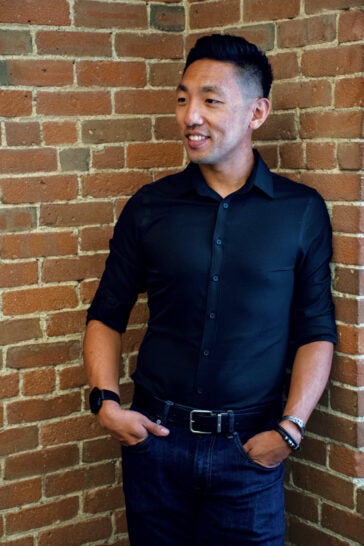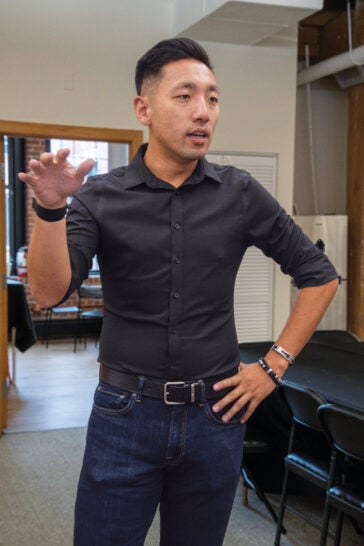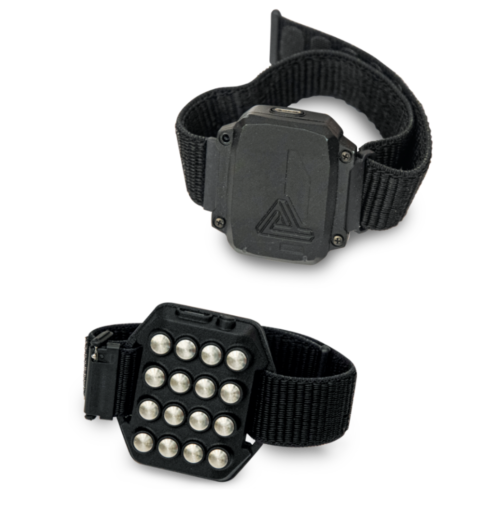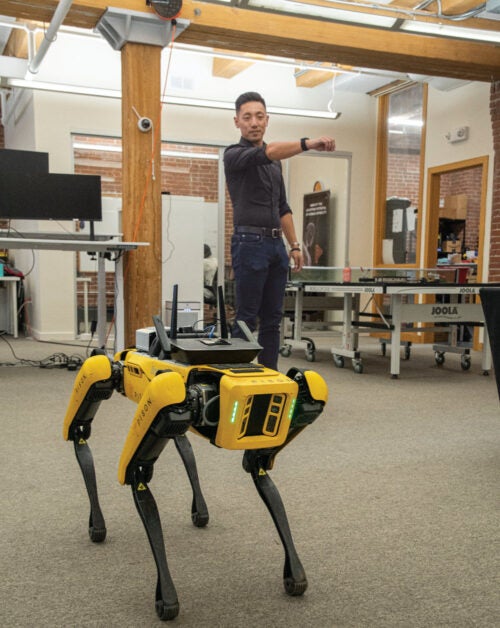With his company, Pison, David Cipoletta ’14, M.S. ’19, is creating devices that allow people to control computers and robots with their brain waves.
By Michael Blanding
David Cipoletta ’14, M.S. ’19, sits in a conference room in a downtown Boston office with walls of exposed brick. Around his wrist is a black plastic device that looks like nothing so much as a Casio calculator watch from the 1980s. A grid of shiny electrodes on its underside, he explains, captures tiny electrical pulses on his wrist, responding to movements of his hand. “Every time you lift your finger, you can see the electrical activity changes,” he says, pointing to red, orange, and green horizontal lines that jump up and down on his Android screen as he lifts his index finger up and down.

“Now, let’s say I want to use a camera app to take a picture,” he says, opening the app on the phone. “I can just swipe up.” He lifts his finger up and down again, and the phone snaps a picture, as if by magic—but that’s only the beginning of what he’s able to do. With more gestures, he can switch to video or turn the flash on or off. “So then, how do I apply the same set of gestures to another function?” he continues, switching to a music app. “I can play, pause, raise the volume, and switch to the next song without touching the screen,” Cipoletta says, moving his finger in various configurations as the app obediently responds to his gestures like a musician playing to a conductor’s baton.
The device is the flagship product of Cipoletta’s company, Pison, a startup that could one day revolutionize how we interact with the world around us—allowing us to control our environment with simple hand gestures. While controlling a camera and music player with a flick of the finger may seem like a cool trick, the company has more serious ambitions. Cipoletta founded it five years ago with Massachusetts Institute of Technology grad Dexter Ang to develop technology that might give independence to people with amyotrophic lateral sclerosis (ALS), otherwise known as Lou Gehrig’s disease, a progressive neurodegenerative disease that gradually leads to loss of control over the body’s muscular system.
A person with ALS could essentially just think of moving their finger, and the electrical pulses in their wrist could translate that intention into action, turning the page of an eBook or opening a webpage without any need for them to actually move their body. As the company has developed the technology, it has found other applications, including new tools for soldiers on the battlefield, for whom it could mean the difference between life and death.

Cipoletta began tinkering with electronics at a young age. He moved to the United States from China at age 12, along with his mother, who holds a doctorate in electrical engineering and got a job designing software for a video camera company. Growing up in Glocester, Rhode Island, Cipoletta was encouraged by his mother and stepfather (who also worked in technology) to explore his interests. Rather than explicitly teaching him, his parents challenged him to find answers to questions himself. “They always said, you are capable to do many things on your own.” And they were right. By searching on internet forums, he taught himself to code in Pascal and began designing websites for pay when he was just 16.
While Cipoletta was still in high school, his mother got him an internship at her company doing data entry, removing duplicates in the database and sending emails to clients. Cipoletta wrote a script that allowed him to automate the work and complete it in just a few days. “They thought that was my whole summer,” he says. “They said, ‘We don’t have work for you anymore.’” They transferred him to warehouse management, and again he created software to automate the task. “I was just very focused on how to do my job more effectively.”
“David is pragmatic; he focuses on what is possible and what isn’t, asking, ‘How are we actually going to Do it and get it done?’”
—Giuseppe Stuto, investor and former Pison COO
At URI, he continued to demonstrate an exceptional work ethic, holding down simultaneous jobs for the school’s computer department, at a private security camera company, and cleaning boats on weekends. “I just always wanted to work—it’s fun for me,” he says. Meanwhile, he rented a two-bedroom apartment, converting one bedroom into a workshop, complete with workbenches, electrical equipment, and 3D printers. “I just always loved tinkering with stuff and building things,” he says. In his spare time, he built himself a working clock and experimented with smart plugs and home automation.
Cipoletta began at URI with two majors, electrical engineering and computer science. But due to a computer glitch, he discovered, to his delight, that he was able to pick up a third major, computer engineering, as well. “My advisor was supposed to block me, but I was never blocked,” he says with a mischievous grin. Cipoletta took summer classes to fulfill the requirements for all three majors—giving him a unique understanding of entire systems, from analog electrical signals to software applications. “I was interested in understanding how to make things work from beginning to end,” he says. For his capstone project at URI, he created a fully automated system for a company conducting DNA sequencing, enabling technicians to check whether the sequencing had been completed correctly by measuring electrical properties in the resulting fluid and running it through a computer algorithm.

After earning his undergraduate degree, Cipoletta took a job with Cambridge, Massachusetts-based Charles River Analytics (CRA), designing underwater unmanned vehicles. “It was one of the hardest jobs I ever had,” he says of the work, which involved piloting underwater robots from boats in Narragansett Bay and San Francisco Bay. “You’ve got a robot you cannot see or talk to; you just have to hope your algorithm works,” he says. At the same time, he pursued a master’s degree in electrical and electronics engineering at URI, taking five years to complete the degree. “It really helped me figure out how to solve complex problems,” he says, “which helped me directly in my work.” His master’s thesis advisor, Professor Fred Vetter, remembers him as “one of the stronger students I’ve ever worked with. He was so motivated and knowledgeable that I didn’t need to ‘advise’ him much—I sort of stayed out of the way and let him make progress.”
It was a class taught by Professor Kunal Mankodiya on wearable technologies that first led Cipoletta to explore devices that could help people with ALS. Initially, he was focused on creating eyeglasses that could help someone control a robotic arm using eye-tracking technology. Having difficulties with the project, however, he showed it to a colleague at CRA, who happened to be in a fraternity with Dexter Ang, an MIT mechanical engineer who was also exploring technology for ALS. Ten years earlier, Ang’s mother had been diagnosed with the disease, and Ang quit his job in finance to return to MIT to explore assistive technologies. Among other things, he wanted to create a way for his mother to independently turn a page in an e-book. “There are a lot of problems a person with ALS might have that we could fix,” Ang says. “How does she call me when she wakes up and needs to get dressed? How does she open a book or click on a website? The digital world should not be limited by a person’s physical capabilities.”
Though his mother died in 2015, Ang continued to pursue the idea to help others. He honed in on the idea of using electrical pulses in the skin to help people with ALS perform tasks, essentially allowing them to control objects through brain signals. When Cipoletta’s colleague mentioned his work to Ang at a fraternity reunion in early 2016, Ang called him right away to tell him about his idea. Two weeks later, Ang visited Cipoletta at his apartment, where Cipoletta had already built a working prototype for the idea, complete with electrical tape holding wires against the skin. “A lot of people in the world say they are going to do something, but do they actually do it? No,” says Ang. “But he had done it. So, I understood right away that he both loves tech, and follows through on his word.”

The two joined forces to create Pison (named after Ang’s mother’s cat, with Ang as chief executive officer and Cipoletta as chief technology officer. Along with a few other engineers, they first pitched the idea to MIT Sandbox, a student-innovation fund, which gave the team $25,000 to pursue it. The following year, the ALS Association gave the company $100,000 out of money raised from its famous Ice Bucket Challenge. Cipoletta and Ang worked well together. “Dexter is the quintessential visionary and dreamer who has that relentless desire to push boundaries,” says Giuseppe Stuto, an early angel investor who met the duo in 2018, and later joined the company as chief operating officer. “David is pragmatic; he focuses on what is possible and what isn’t, asking, ‘How are we actually going to do it and get it done?’”
In the conference room at Pison, Cipoletta turns over the device on his wrist to reveal a grid of 16 small metal electrodes, which sit against the device wearer’s wrist. As they move their fingers, pulses of electrical energy travel through their nerves as their muscles move. The device measures the difference in electrical potential between electrodes for each gesture. It then uses a machine learning algorithm to identify the unique electrical pattern for each movement to convert it into a specific action performed by a computer app or a robot. The device works for people with ALS because their brains still send electrical signals through their nerves, even though the muscles don’t respond, allowing the device to intercept them and hack them for its own purposes. “The muscle is almost like the output to a speaker, but it’s the wire that is sending these pulses,” says Cipoletta. “We’re just trying to tap into the wire to identify these electrical signals, and then train them to perform a different output.”
A person could just think of moving their finger, and the electrical pulses in their wrist could translate that intention into action.
Cipoletta’s unique background has helped him design the device’s system from beginning to end, including capturing the electric signals, digitizing them, and then translating them through software. Making the gestures perform actions, however, is not quite as simple as it sounds. To properly decode the signals, the device must filter out electromagnetic interference in buildings to isolate the relatively weaker signals from the body. In the case of ALS, it’s even more difficult since the pulses are so much weaker compared to a person without ALS.
“Our origins are in ALS, so the quality of what goes into designing the device is better than if we had designed it for able-bodied individuals,” says Tanya Wang ’13, who met Cipoletta while working as a technician in the biomedical engineering lab at URI. “I would suggest that makes it better for all other applications as well.” Wang took courses with Cipoletta while he was studying for his master’s degree. On the first day of one class, they were competing neck-and-neck on an icebreaker activity to see who could build the highest structure out of hard spaghetti strands, and he told her he was going to start his own company one day and hire her.
“In my mind, it was this crazy joke,” she says. Nevertheless, he did hire her as an electrical engineer in 2016; her job now is to help design the schematics for the circuit board to fit all the technology for signal capture, processing, and shielding interference into a small watch-like space. “I really enjoy designing the circuits,” she says. “It’s like a puzzle to see how intricately I can fit things in.”
Pison staffers at work in the company’s Boston, Mass., offices.
While Pison was initially focused on developing a device to help people with ALS, Ang and Cipoletta quickly realized that the market for accessibility products wouldn’t be big enough to make the company viable in the short-term. “A lot of venture capital companies and investors aren’t interested in funding this disability access business because the market is too small,” Cipoletta says. On the other hand, developing for the consumer market, for example, risked competition from bigger players, like Google, Microsoft, and even entrepreneur Elon Musk’s startup, Neuralink. In searching for other markets, they hit upon one customer in urgent need of the technology, whom they could also serve exclusively—the U.S. Department of Defense (DOD).
“For the general public, this kind of thing is a ‘nice-to-have,’” Cipoletta explains. That is, it’d be fun to be able to take a picture or change your music with the flick of a finger, but it’s not a necessity. “For a soldier, it’s a ‘must-have.’” That’s because a soldier in the battlefield is weighed down with heavy equipment—a pack, a radio, body armor. In an urban environment, however, they may face incoming fire from a building and need to point out to fellow soldiers where the enemy is shooting from. Typically, that means looking down at a device around their neck and trying to mark a target on a GPS map with a stylus. “A lot of times, they are wearing gloves, and the stylus doesn’t even work,” Cipoletta says.
“For me, the gratification comes from helping people, and knowing that people find a need for what I make.”
—David Cipoletta, co-founder and CEO of Pison
Making those situations even more perilous, looking down at their portable screens while marking the target, increases the chance that they may be shot by an enemy while they are preoccupied. By contrast, with a gesture control device, they could simply point at an enemy and automatically mark the location on a map through Bluetooth, showing their fellow soldiers where to fire without taking their eyes off the target.
Another application Pison is exploring is drone control. For example, at a checkpoint where a drone is used to investigate a suspicious vehicle, a soldier would typically need to look down at a remote to pilot the device. But if an enemy vehicle rammed through the checkpoint, it could take precious time for a solider to react and bring a weapon to bear. “If you are able to control the drone by pointing, you are ready if something runs the roadblock and comes at you,” Cipoletta says.
With this dual strategy of developing an immediate device for the military, as well as a longer-term goal of creating solutions for ALS, Pison was able to raise $7 million in series-A funding this past spring, bringing its total funding to $11 million. Even as it works on these ambitious twin goals, the company continues to explore other options, with ongoing contracts with Google, Samsung, and Mitsubishi to create devices that might ultimately be used in home or business situations. Ultimately, its experience may allow it to compete with those bigger companies in the consumer space.
“A lot of these older equipment manufacturers take longer to develop a product because they’re not really focused on the user today,” says Stuto, who recently left Pison to launch his own venture capital firm. “A start-up doesn’t have that liberty. It needs to be focused on real users.” By creating a product today for the military, Pison hopes to gain valuable experience in designing a working product before any competitors. “The DOD space is a good environment for us to build up some cash and develop our technology before we go out to compete more broadly.”
Recently, Ang stepped down as CEO to become chief innovation officer, interfacing with external partners to drum up new business opportunities, while Cipoletta has taken over as interim CEO. He’s hoping that within the next five to 10 years, the company will achieve its original dream of creating devices to help people with disabilities such as ALS, at the same time it starts to tackle products for the consumer market.
Whether creating devices to help a person with a disability become more independent, a soldier survive in a war zone, or an average person change the television channel, Cipoletta is motivated by the idea that he can create devices that people can use in the immediate future to make their lives better. “Many engineers spend all their time on research and development for things that are never used,” he says. “For me, the gratification comes from helping people, and knowing that people find a need for what I make. That’s just the best feeling an engineer can have.” •
Michael Blanding has written for The New York Times, WIRED, Slate, and The Boston Globe. His book North by Shakespeare: A Rogue Scholar’s Quest for the Truth Behind the Bard’s Work recently won the International Book Award for narrative nonfiction.
PHOTOS: Nora Lewis
